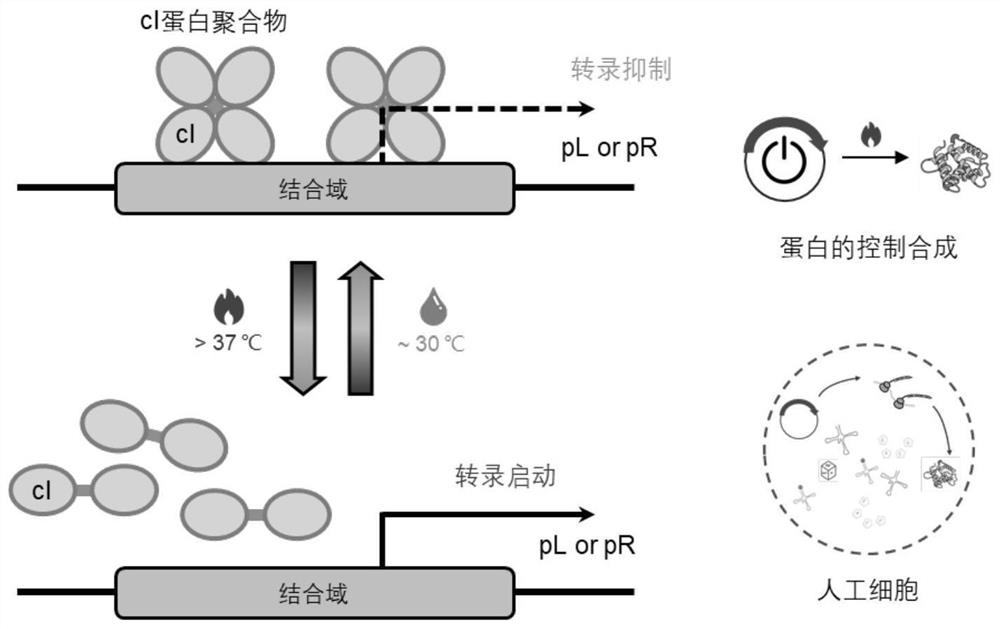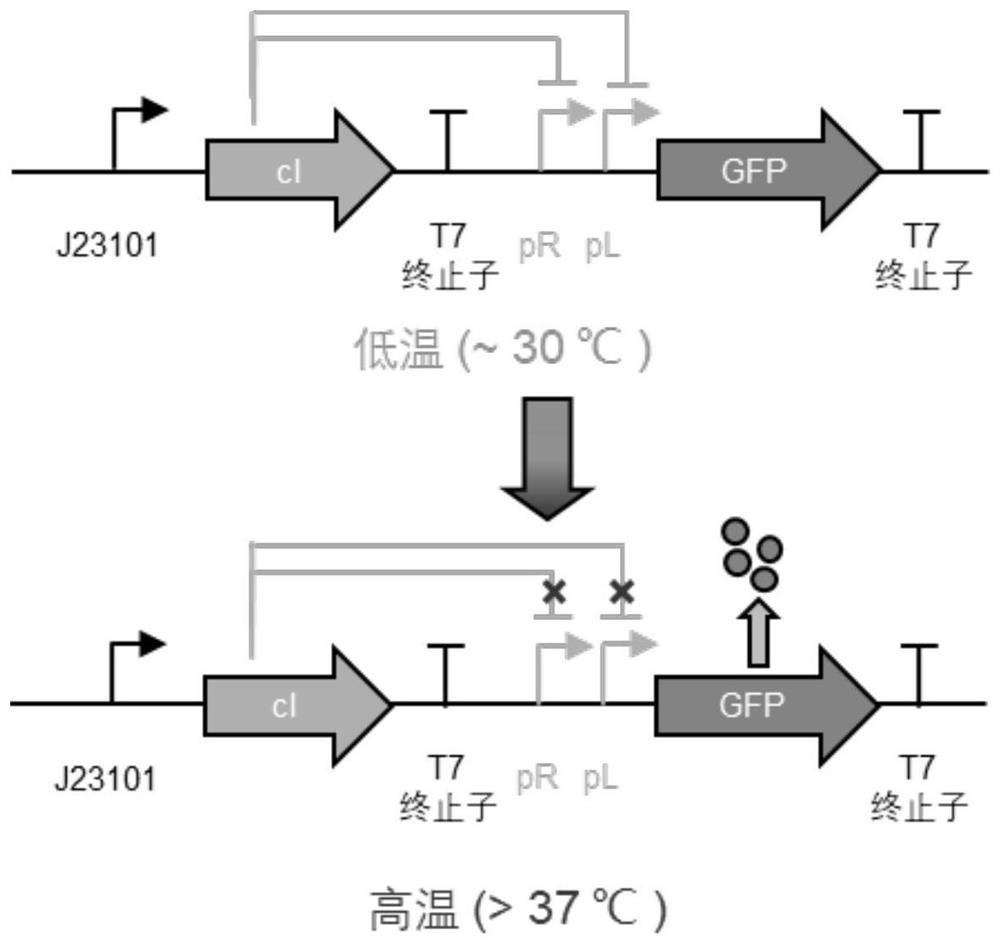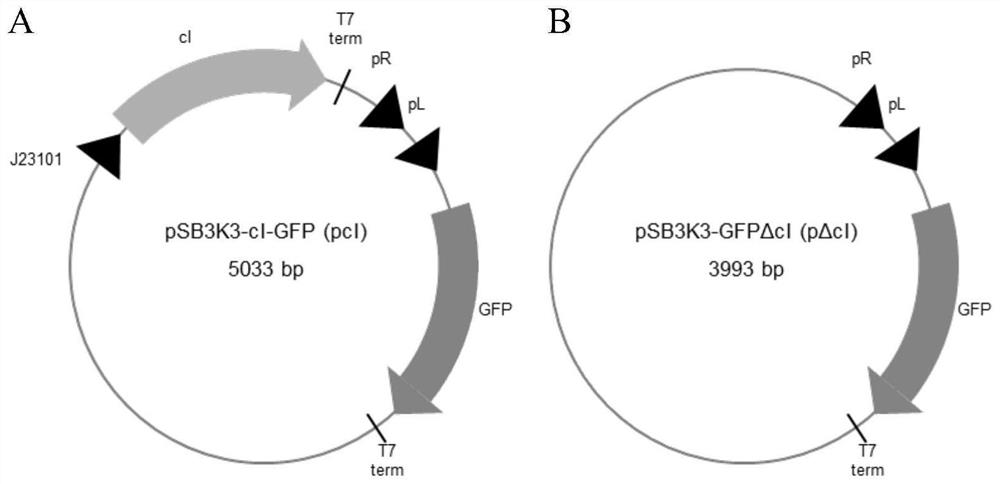Construction method of temperature-controlled cell-free reaction system, plasmid used by method and application of plasmid
A reaction system, cell-free technology, applied in the direction of using vectors to introduce foreign genetic material, other methods of inserting foreign genetic material, medical preparations of non-active ingredients, etc., can solve the problem of effective control of protein expression, cell metabolism intensity and metabolism Flow changes, adverse effects of target pathways, etc., to achieve good temperature control and low cost effects
- Summary
- Abstract
- Description
- Claims
- Application Information
AI Technical Summary
Problems solved by technology
Method used
Image
Examples
Embodiment 1
[0121] Example 1: Plasmid construction
[0122] The bacteriophage lambda repressor cI is a well-known temperature-sensitive variant that acts on the tandem pR-pL operator-promoter and can efficiently regulate genes cloned downstream of the promoter. When the temperature is below 37°C (usually 28-32°C), it represses gene expression, while when the host RNA polymerase raises the temperature above 37°C, the mutated repressor is inactivated and transcribed, the regulation mechanisms such as figure 2 shown.
[0123] All plasmids used in the present invention were constructed according to standard molecular biology techniques.
[0124] In the present invention, the pSB3K3 plasmid (purchased from Addgene (Addgene#78636)37) is used as the backbone, and the green fluorescent protein GFP is selected as the reporter protein (synthesized by GENEWIZ company). The fluorescent reporter gene was cloned by Gibson assembly under the control of the pL / pR promoter, and the expression suppress...
Embodiment 2
[0132] Example 2: Expression of plasmids in cell systems
[0133] The pcI plasmid and pΔcI plasmid were transformed into E. coli BL21 Star (DE3) and cultured at 30°C and 37°C for 12 hours, respectively. The OD600 and fluorescence intensity of the bacterial solution were then determined. The result is as Figure 4 As shown, the GFP level of the pcI plasmid at 37°C was higher than that at 30°C, confirming that the constructed pcI plasmid could activate the expression of the target protein at the expected high temperature in the cells.
Embodiment 3
[0134] Example 3: Expression of plasmids in cell-free systems
[0135] The protein synthesis control ability of tcCFPS was tested by adding the pcI plasmid directly to the cell-free system and initiating the reaction at different temperatures.
[0136] - Preparation of Escherichia coli BL21 Star (DE3) cell-free extract (abbreviated as BS)
[0137] For overnight culture with E. coli, 200 mL of 2×YT-P medium was inoculated into a 1-L flask at a dilution ratio of 1:20. The culture was added to a 4 l fermenter and incubated at 37°C, 500 rpm for 3.5 hours. Cell beads were washed twice with 100 mL of ice-cold S30A buffer (14 mM mg-glutamic acid, 60 mM k-glutamic acid, 50 mM Tris, pH 7.7) and then centrifuged at 8000 xg for 15 minutes at 4°C. Then, the cell microspheres were resuspended in 30 ml of frozen S30A buffer, transferred to a pre-weighed 50 ml Falcon conical tube, and centrifuged at 10,000 × g for 10 minutes at 4°C. Finally, the tubes were reweighed and snap-frozen in nit...
PUM
 Login to View More
Login to View More Abstract
Description
Claims
Application Information
 Login to View More
Login to View More - R&D
- Intellectual Property
- Life Sciences
- Materials
- Tech Scout
- Unparalleled Data Quality
- Higher Quality Content
- 60% Fewer Hallucinations
Browse by: Latest US Patents, China's latest patents, Technical Efficacy Thesaurus, Application Domain, Technology Topic, Popular Technical Reports.
© 2025 PatSnap. All rights reserved.Legal|Privacy policy|Modern Slavery Act Transparency Statement|Sitemap|About US| Contact US: help@patsnap.com



